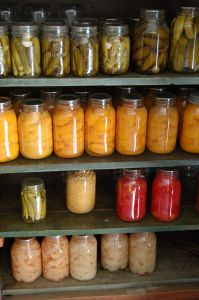
There’s a lot of can canning going on in my kitchen these days. This damp, sticky dance involves a lot of careful footwork and arm-lifting and a little bit of yelling upon occasion, as boiling hot water runs onto a part of me that doesn’t want to be exposed to boiling water.
Yes, it’s canning time.
This year I’ve done a whole lot of freezing. However, given that my freezers are mostly full now, I’m turning the focus to canning now. What I’ve discovered is that given my propensity to freeze jams and sauces in canning jars, I have very few jars left.
This has sent me on a hunt for canning jars. Since I prefer secondhand, both for environmental and budget reasons, I need to know my jars. If you have a potential source of secondhand canning jars, here are a few tips for sourcing them.
Think about what you’re going to can. If it’s jam, smaller jars will do. If it’s fruit, you will likely need large jars. Stock up on what you’ll actually use.
Look for jars that fit modern lid sizes. Old jars may need a slightly different size of lid.
For my sanity, I stick with wide-mouthed and standard lids. Bring a lid along to figure out how big the jar tops are. Gem jars are another option: they are slightly larger than standard and always get me confused. I stick with one big and one small size to reduce the confusion.
Look for screw caps that are not rusted or bent. Bent screw caps may not allow the lid to sit on the jar correctly, leading to a bad seal.
Inspect each jar carefully before taking it or using it. They should be visibly clean or able to be cleaned easily, and they should have no nicks or cracks. Cracks can lead to shattered glass in your canner.
Do you can? How do you find new jars and care for your old ones?
Image Credit: turbidity

